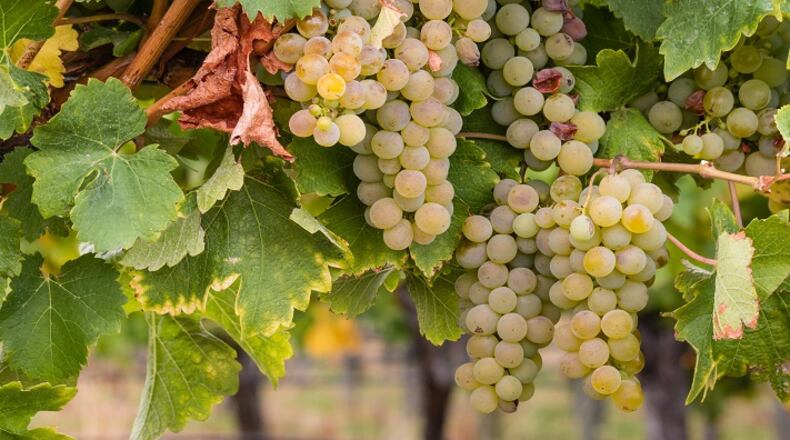There are a few things about riesling that we can count on for sure. One is that it is pronounced “REECE-ling,” with an “s” sound and not a “z” sound. Another is that not all of it is sweet, and in fact, the vast majority of it is dry. And finally, wine folks are enraptured by this classic white grape variety.
Why are so many people afraid of it? People of a certain age might associate riesling with the sweet German wines peddled in supermarkets decades ago, before good and varied wines were readily available to the average shopper. Having witnessed scrunched-up faces at the mention of riesling, younger drinkers might think of riesling as a red-flag word. They, too, might think of it as cheap, sweet wine with no pizzazz. Often, the complete opposite is true. Riesling, which is usually made into 100 percent varietal wines, offers pizzazz to spare. Its many iterations can turn the riesling-averse into devotees. All riesling needs is a chance.
This is a wine that can be tart, and as dry as a sun-baked river stone or kissed with sweet, ripe tropical fruit and honey when its grapes have been affected by Botrytis cinerea, aka noble rot, or transformed into icewine, where the grape freezes on the vine, concentrating the sugars. In between those extremes lies riesling’s greatest asset, its bright acidity. This balances typically sweetness, and what makes riesling such a great food wine. Riesling rarely comes into contact with new oak, and white wine lovers who prefer “dry and crisp” over “buttery” should take particular note.
Riesling can be light- to medium-bodied, with low to medium alcohol, and offer everything from floral notes, minerality, citrus (particularly lemon and/or lime), spice, green apple, honey, pear, peach, apricot and other stone fruits to melon and other tropical fruits, toast, earth and smoke. And then there’s that telltale aroma of “petrol” — the word the British use for gasoline. It’s not necessarily a bad thing. In fact, some people love it.
To help you determine just how sweet or dry the bottle of riesling you are looking at is, the International Riesling Foundation (IRF) developed a chart that appears on some back labels. In the form a left-to-right sliding scale, it features an arrow pointing to a spot in relation to the following words: dry, medium dry, medium sweet, sweet.
Off-dry riesling lands in the “medium dry” area, somewhere between a quarter of the way in and the halfway point. The bright fruit and touch of sweetness in off-dry riesling is the perfect match for foods that bring a little heat, particularly spicy Asian cuisine like Thai, Indian and Chinese. Don’t be scared away by the sweetness. Remember — that racy acidity will be there to keep everything in check. All you will encounter is the bright, fresh fruit of the wine, along with any other notes it might offer. But it won’t seem “sweet” in a bad way, any more than a piece of fruit’s sweetness is bad. Mouthwatering acidity is the key.
Drier styles of riesling pair well with shellfish and other light seafood, chicken and pork. Some of those drier styles are also great as aperitifs — wines that will not leave you searching for a glass of water after every sip.
Some labels will specify “dry riesling,” but on German labels “Trocken” means dry, and “Halbtrocken” means half-dry. If neither word appears, you might be looking at a wine with anything from a touch of sweetness to an all-out sweet riesling suitable for dessert.
The grape variety is believed to hail from Germany, and nowhere on earth is more of it planted. German rieslings come in the full range of styles, and some of the country’s most notable spots for it are the Mosel, Rheingau, Rheinhessen and Pfalz regions. The Alsace region of France, just across the German border (and once part of Germany itself), is famous for its dry rieslings. Likewise, Austria turns out dry, often medium-bodied riesling in the Wachau region.
In Australia, the Clare Valley and Eden Valley regions produce rieslings that are a study in fresh, tangy lime-citrus notes. New Zealand also produces a fair amount of riesling, and in our part of the world, Washington, Oregon, California and Michigan turn out the gamut of styles, as does New York, perhaps most successfully in the Finger Lakes region. In Canada, New York and Germany, among other places, riesling grapes are turned into the aforementioned rich, sweet, dessert-friendly icewine (aka “eiswein”).
Because of its high acidity, riesling is known for its ageability, a white wine that can develop in the bottle for years, often without requiring a huge outlay of cash. Some top bottlings, which can inch up the price scale, are able to age for decades. Considering the complexity and aging potential that riesling offers, it could often be reasonably considered a bargain — a versatile wine style that the most-experienced wine folks appreciate and love. Get past the myths and you will see for yourself.
About the Author
The Latest
Featured


